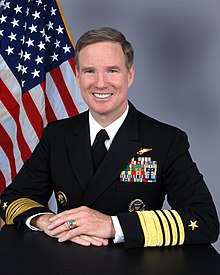
The United States Pacific Fleet (USPACFLT) is a theater-level component command of the United States Navy, located in the Pacific Ocean. It provides naval forces to the Indo-Pacific Command. Fleet headquarters is at Joint Base Pearl Harbor–Hickam, Hawaii, with large secondary facilities at Naval Air Station North Island, California.
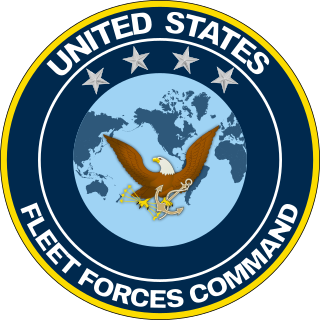
The United States Fleet Forces Command (USFFC) is a service component command of the United States Navy that provides naval forces to a wide variety of U.S. forces. The naval resources may be allocated to Combatant Commanders such as United States Northern Command (USNORTHCOM) under the authority of the Secretary of Defense. Originally formed as United States Atlantic Fleet (USLANTFLT) in 1906, it has been an integral part of the defense of the United States of America since the early 20th century. In 2002, the Fleet comprised over 118,000 Navy and Marine Corps personnel serving on 186 ships and in 1,300 aircraft, with an area of responsibility ranging over most of the Atlantic Ocean from the North Pole to the South Pole, the Caribbean Sea, Gulf of Mexico, and the waters of the Pacific Ocean along the coasts of Central and South America.

The Fifth Fleet is a numbered fleet of the United States Navy. Its area of responsibility encompasses approximately 2.5 million square miles, and includes the Persian Gulf, Red Sea, Arabian Sea, and parts of the Indian Ocean. It shares a commander and headquarters with U.S. Naval Forces Central Command (NAVCENT) in Bahrain. Fifth Fleet/NAVCENT is a component command of, and reports to, U.S. Central Command (CENTCOM).
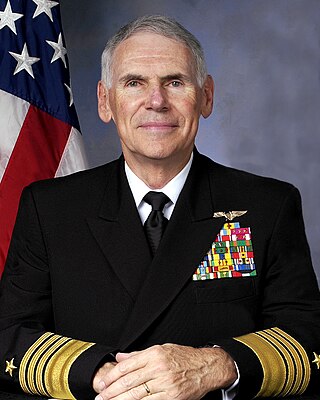
William Joseph Fallon is a retired United States Navy four-star admiral who retired after serving for over 41 years. His last military assignment was as Commander, U.S. Central Command from March 2007 to March 2008. ADM Fallon was the first Navy officer to hold that position. His other four-star assignments include Commander, U.S. Pacific Command from February 2005 to March 2007, Commander, U.S. Fleet Forces Command from October 2003 to February 2005, and 31st Vice Chief of Naval Operations from October 2000 to August 2003. On March 11, 2008, he announced his resignation from CENTCOM and retirement from active duty, citing administrative complications caused in part by an article in Esquire Magazine, which described him as the only thing standing between the Bush Administration and war with Iran.

Forrest Percival Sherman was an admiral in the United States Navy and the youngest person to serve as Chief of Naval Operations until Admiral Elmo Zumwalt in 1970. The Forrest Sherman-class destroyer and the airfield at Naval Air Station Pensacola were named for him.

Timothy John Keating is a retired United States Navy admiral. During his career, he served as commander of Carrier Group Five, the United States 5th Fleet, the United States Northern Command and North American Aerospace Defense Command (NORAD), and United States Pacific Command. He retired in 2009 after more than 38 years of service. He was the first navy officer to head Northern Command and NORAD.

John B. Nathman is a retired United States Navy admiral who served as the Commander, United States Fleet Forces Command until 17 May 2007.
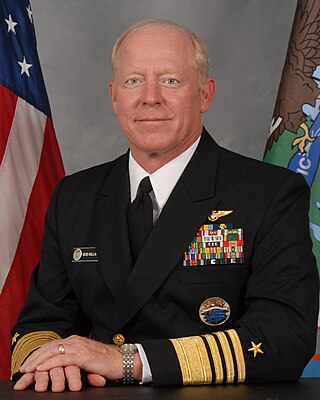
Robert Frederick Willard is a retired United States Navy admiral who last served as the 22nd Commander, U.S. Pacific Command from October 19, 2009 to March 9, 2012. He previously served as Commander, U.S. Pacific Fleet from May 8, 2007, to September 25, 2009. Prior to that, he served as the 34th Vice Chief of Naval Operations from March 18, 2005, to April 2007. On March 9, 2012, Admiral Willard retired from the Navy after 39 years of service. On May 9, 2012, he was elected president and chief executive officer of the Institute of Nuclear Power Operations, succeeding retired Navy admiral James O. Ellis Jr.

Admiral William Floyd Bringle was a senior officer in the United States Navy. He was the first commanding officer of USS Kitty Hawk (CV-63), commanded the United States Seventh Fleet from 1967 to 1970 during the Vietnam War, and as commander, United States Naval Forces Europe from 1971 to 1973.

Admiral James Oren Ellis Jr. is a retired 4-star admiral and former Commander, United States Strategic Command, Offutt Air Force Base, Nebraska. He was President and Chief Executive Officer, Institute of Nuclear Power Operations until May 2012. He joined the board of directors of Lockheed Martin in 2004, and served until 2024.

William Evans "Bill" Gortney is a retired United States Navy admiral who served as the sixth commander of United States Northern Command and the 23rd commander of North American Aerospace Defense Command (NORAD). He previously served as the Commander, United States Fleet Forces Command from September 14, 2012 to December 2014 and Director of the Joint Staff from July 1, 2010 to August 2012. Prior to that, he served as Commander, U.S. Naval Forces Central Command/5th Fleet. He assumed his post as CDRUSNORTHCOM and commander of NORAD on December 5, 2014, and was succeeded by General Lori Robinson on May 13, 2016.

Thomas Henry Copeman III is a retired officer of the United States Navy. In mid-2009 he was appointed commandant of the Guantanamo Bay detention camps, in Cuba. His final assignment was as Commander, Naval Surface Forces Pacific from July 2012 to August 2014.

Rear Admiral Jesse Alphonzo Wilson Jr. is a retired United States Navy officer. His last active duty assignment was as commander of Naval Surface Force Atlantic.

Vice Admiral Scott Ray Van Buskirk, is a retired United States Navy officer who was the 56th Chief of Naval Personnel. He served as the CNP from October 2011 to August 2013. He was succeeded by Vice Admiral William F. Moran and retired after 34 years of service. He is one of only two submarine officers to have commanded a carrier strike group.
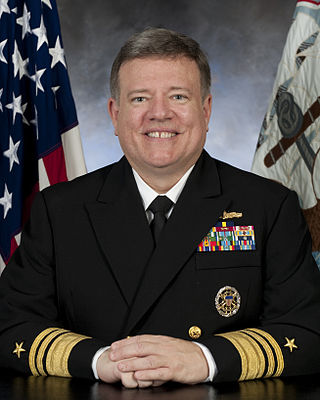
Peter Hasten Daly is a retired United States Navy vice admiral who served as Deputy Commander and Chief of Staff, U.S. Fleet Forces Command. He was the CEO of the United States Naval Institute from 2011 until 2023.

Destroyer Squadron 50 is a destroyer squadron of the United States Navy. The squadron was first formed during World War II when the squadron commodore and his staff led ships in the Pacific Theater from October 1943 until its disestablishment in November 1945. The squadron was equipped with nine Fletcher-class destroyers, comprising Destroyer Divisions (DesDivs) 99 and 100.

Scott Harbison Swift is a retired admiral in the United States Navy, serving as the commander of the U.S. Pacific Fleet from May 27, 2015 to May 17, 2018. He previously served as the director of Navy Staff in the office of the Chief of Naval Operations.

John Christopher Aquilino is a retired United States Navy admiral who last served as the commander of United States Indo-Pacific Command from 2021 to 2024. He previously served as the commander of the United States Pacific Fleet and before that, commander of the United States Fifth Fleet and Combined Maritime Forces.

Christopher Watson Grady is a United States Navy admiral who is currently serving as the 12th vice chairman of the Joint Chiefs of Staff since December 20, 2021.

Michael A. Brookes is a United States Navy rear admiral who serves as the director of the National Maritime Intelligence-Integration Office and commander of the Office of Naval Intelligence. He previously served as the director of intelligence of the U.S. Southern Command and U.S. Strategic Command.
